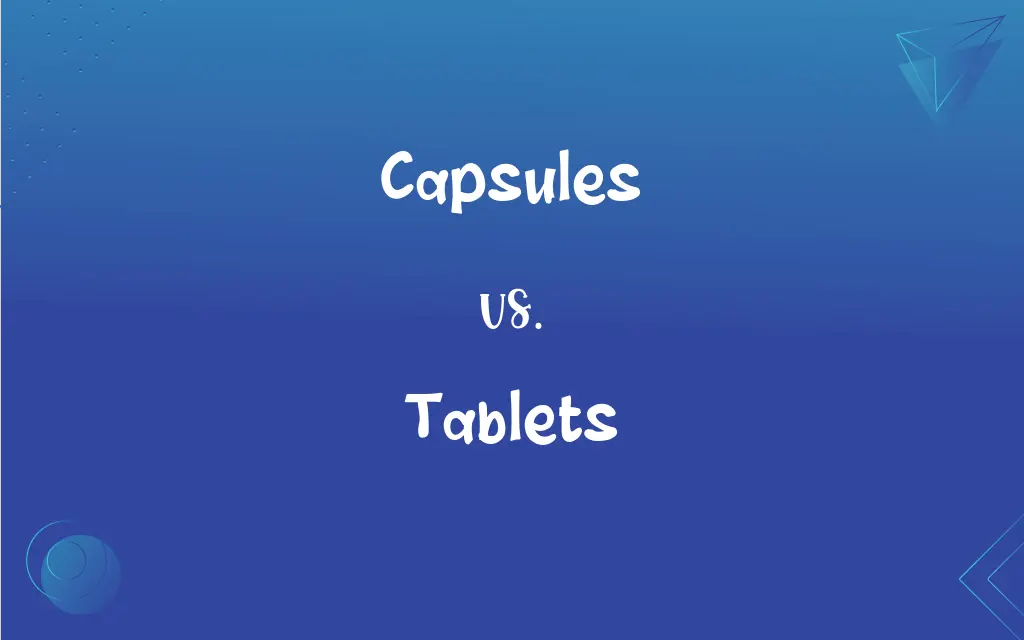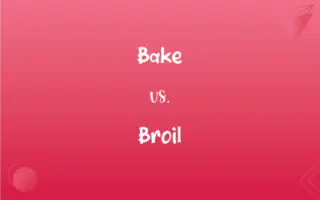Capsules vs. Tablets: What's the Difference?
Edited by Janet White || By Harlon Moss || Updated on October 4, 2023
Capsules are small, cylindrical containers usually made of gelatin that enclose medicines, while tablets are solid, flat or biconvex discs where the drug is compressed or compacted.

Key Differences
Capsules offer a shell, often made from gelatin, that encloses a drug or supplement, providing a smooth exterior which some find easier to swallow. Tablets, on the other hand, are a compacted form of the drug and might sometimes have a coating, but they don’t encapsulate the drug inside.
Capsules can often be opened to mix their contents with food or drinks, making them versatile for those with swallowing difficulties. Tablets typically do not offer this flexibility as they are a solid, compressed form of medication.
The production process for capsules usually involves filling the capsule shell with the appropriate medication or supplement. In contrast, tablets are made by compressing the drug with binders, fillers, and other agents to maintain their shape.
The dissolution rate, or how quickly the medication is released into the system, can differ between capsules and tablets. Capsules tend to dissolve faster and release their contents more quickly, whereas tablets might have varied release rates based on their composition.
While both capsules and tablets are designed to deliver medication effectively, personal preferences like ease of swallowing, the flexibility of dosing, and rate of drug release might determine which form is more suitable for an individual.
ADVERTISEMENT
Comparison Chart
Composition
Gelatin or similar shell
Compressed drug with binders and fillers
Dissolution Rate
Tends to dissolve faster
Variable, can be immediate or extended
Flexibility
Can be opened to mix contents
Typically consumed as is
Appearance
Cylindrical, often transparent
Flat or biconvex discs
Coating
Natural shell, sometimes coated
Often coated for ease of swallowing
ADVERTISEMENT
Capsules and Tablets Definitions
Capsules
Hollow enclosures used for enclosing medicine.
The vitamin supplement comes in capsules filled with powder.
Tablets
Solid doses of medication compressed into small discs.
Many over-the-counter pain relievers are available as tablets.
Capsules
Small edible containers for liquid or powdered drugs.
The fish oil capsules provide omega-3 fatty acids.
Tablets
Flat or biconvex discs containing medicinal substances.
She broke the tablets in half to make them easier to swallow.
Capsules
Gelatinous shells filled with a substance.
The patient found the red and blue capsules hard to differentiate.
Tablets
Compressed units of drugs meant for oral administration.
The patient was instructed to take two tablets daily.
Capsules
Medicine enclosed in a digestible container.
The doctor prescribed antibiotics in the form of capsules.
Tablets
Pills made by compressing powders.
Chewable tablets are often flavored for children.
Capsules
Cylindrical containers made from gelatin.
Many prefer capsules because they can be easier to swallow.
Tablets
Solid forms of medication made for easy consumption.
Some tablets come with a scored line for easy splitting.
Capsules
A small soluble container, usually made of gelatin, that encloses a dose of an oral medicine or a vitamin.
Tablets
A slab or plaque, as of stone or ivory, with a surface that is intended for or bears an inscription.
Capsules
(Anatomy) A fibrous, membranous, or fatty sheath that encloses an organ or part, such as the sac surrounding the kidney or the fibrous tissues that surround a joint.
Tablets
A thin sheet or leaf, used as a writing surface.
Capsules
(Microbiology) A polysaccharide outer shell enveloping certain bacteria.
Tablets
A set of such leaves fastened together, as in a book.
Capsules
A dry dehiscent fruit that develops from two or more united carpels.
Tablets
A pad of writing paper glued together along one edge.
FAQs
What are capsules?
Capsules are small, cylindrical containers, often made of gelatin, that enclose and deliver medicines.
Why might someone choose capsules over tablets?
Capsules can be easier to swallow for some, and their contents can be mixed with food or drink.
Are all tablets slow to dissolve?
No, the dissolution rate of tablets varies, with some being immediate-release and others being extended-release.
Why might a medication be available as both a capsule and a tablet?
Different forms can cater to patient preferences, dosing requirements, or specific release profiles.
Which is more expensive to produce, capsules or tablets?
Costs can vary based on formulation and production factors, but capsules can sometimes be more expensive due to their encapsulation process.
Can both capsules and tablets have coatings?
Yes, while capsules have a natural shell, both can have added coatings for various reasons.
Do tablets always contain binders and fillers?
Most tablets contain binders and fillers to help with compression and maintain shape, but the specific components can vary.
Can I crush tablets and encapsulate them?
Only if advised by a healthcare professional, as it might affect the drug's release rate or efficacy.
Are capsules always filled with powder?
No, capsules can contain powders, liquids, or even tiny tablets known as pellet-filled capsules.
Can I achieve extended-release with both capsules and tablets?
Yes, both forms can be formulated to provide immediate or extended-release of the drug.
Are all tablets hard, or can they be soft?
While most tablets are hard, there are soft chewable tablets available, especially for pediatric and geriatric patients.
Are tablets typically bigger than capsules?
Not necessarily. Both tablets and capsules come in various sizes.
Are capsules always made of gelatin?
No, while many are gelatin-based, there are also vegetarian and other alternatives available.
Are there any storage differences between capsules and tablets?
Both should be stored as directed, but capsules might be more sensitive to moisture due to their gelatinous shell.
How are tablets different from capsules?
Tablets are solid, compressed doses of medication, while capsules enclose the drug inside a shell.
Which releases its contents faster, capsules or tablets?
Generally, capsules dissolve faster and release their contents more quickly, but it can vary based on the specific formulation.
Are chewable forms available for both capsules and tablets?
Chewable forms are typically tablets, but some capsules may contain chewable contents inside.
Can both capsules and tablets be split in half?
Tablets can often be split, especially if scored, but capsules are not designed to be split.
Which is more tamper-evident, capsules or tablets?
Both have their vulnerabilities, but tampering might be more noticeable with capsules due to their clear shells.
Can capsules be opened and mixed with food?
Often, yes. Capsules can be opened to mix their contents with food or drinks.
About Author
Written by
Harlon MossHarlon is a seasoned quality moderator and accomplished content writer for Difference Wiki. An alumnus of the prestigious University of California, he earned his degree in Computer Science. Leveraging his academic background, Harlon brings a meticulous and informed perspective to his work, ensuring content accuracy and excellence.
Edited by
Janet WhiteJanet White has been an esteemed writer and blogger for Difference Wiki. Holding a Master's degree in Science and Medical Journalism from the prestigious Boston University, she has consistently demonstrated her expertise and passion for her field. When she's not immersed in her work, Janet relishes her time exercising, delving into a good book, and cherishing moments with friends and family.
































































